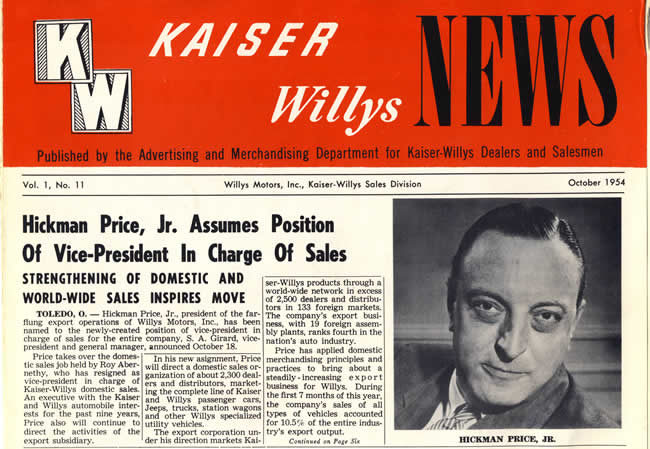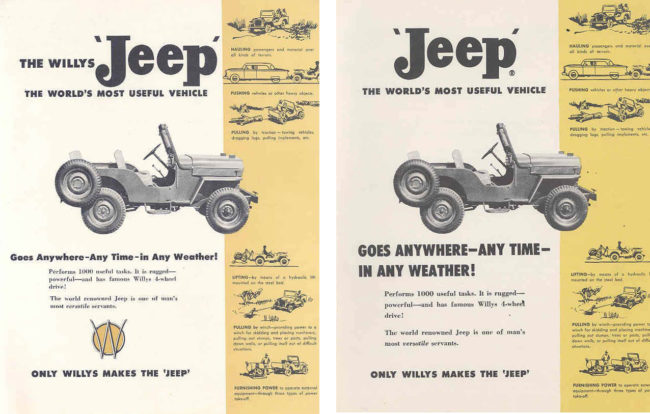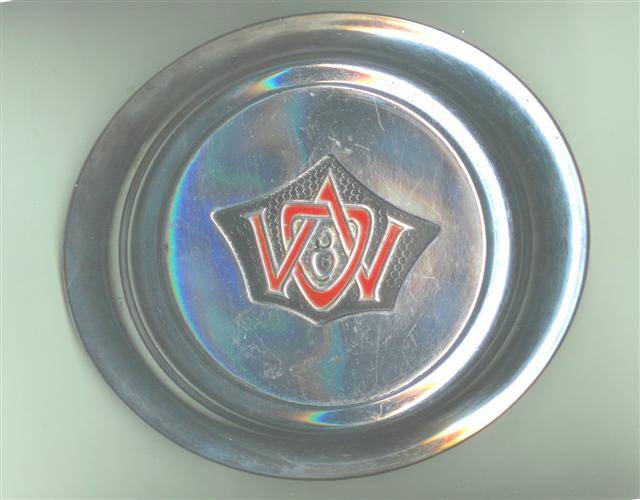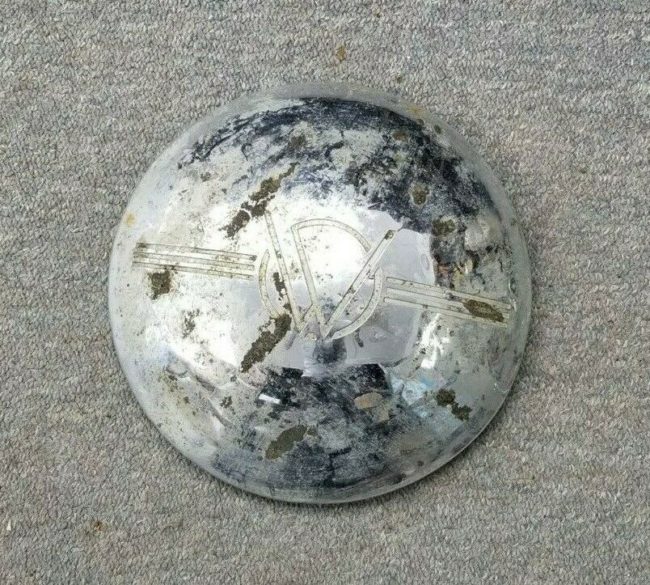This brochure was available via eBay at some point. The images are from worth point. Cool brochure! You can see other loaders and images at this Farm Collector page.
Here’s a brochure posted back in 2013 of a 1948 Baldwin brochure:
This brochure was available via eBay at some point. The images are from worth point. Cool brochure! You can see other loaders and images at this Farm Collector page.
Here’s a brochure posted back in 2013 of a 1948 Baldwin brochure:
This is the Willys-Overland Export Corporation version of this style of brochure, form SX-227-4:
Domestic version of brochure, Form W-227-5 (images from eBay):
1955 Station Wagon brochure form W-221-5 (see W-221-4, predecessor to this brochure):
This 24 page brochure is labeled form W-992-5. An article about the brochure was published in May 1955 issue of the Willys Dealer News.
Maury spotted this unusual postcard. The starting auction price is a crazy $39.95, but it’s a pretty cool postcard none-the-less.
View all the information on eBay
“Wow! This is a wonderful vintage 1953 postmarked postcard. Scene shows a view of the Big Flowing Orange and Ben Eastman Family on a Jeep at their Citrus Stand in Sebring, FLA. Postcard is in very good condition with some light wear and is postally used.”
Here’s a brochure (Form 471A10) that I missed on eBay last year (and that I’ve never seen).
Text from eBay ad: “This listing is for a Rare Vintage 1947 Universal Jeep Book titled Jeeps or Tractors in the Farm Plan. This booklet is 17 pages, measures 8×10, made in USA, form 471A10. This book compares using a tractor to a Jeep on the farm. The item “RARE Vintage 1947 Willys Jeep or Tractor Brochure Farm Plowing Comparison Book”” (from this page)
I’m not sure how much these signs run these days.
https://southjersey.craigslist.org/atq/d/paulsboro-willys-sign/7053326937.html
“From the 40s! 8 out of ten in quality! We have had this for decades! 675 dollars or best offer.”
UPDATE: The location has been identified as “Oceano Dunes SVRA a state park located by Pismo Beach Cal. It is not as open to day as it was back then”.
Ted shared this catalog cover from an ancient Novak catalog.
UPDATE: The early version of this brochure (form SD-203-4) can be found here.
This form W-203-5 was part of the 1954 family of brochures.
This 24 page brochure, W-1772, is a little large for my scanner, so I’d put off scanning it. A few days ago I was investigating various large format scanning strategies (bigger than 12″x9″). Below is a test of some free IOS software from Evernote. It’s not perfect, but it sure was quick and I could see using this software when going over old documents at a library, stuff where time is more important than performance.
I might also try one of those new overhead. portable book scanners, though some of these require your computer to provide Admin access, which is a little suspicious (especially since a couple users noted that the unit was causing communications to occur to China).
Anyway, once I get a large format scanner, I’ll get some better scans of this one.
Not in perfect shape, but a reasonable price.
https://www.facebook.com/marketplace/item/799775637112471/
“Rare hard to find mailer newspaper to advertise the first CJ.”
INTEGRATING KAISER MOTORS WITH WILLYS MOTORS:
As mentioned in the 1955 testimony by Edgar Kaiser, initially when Kaiser purchased the Willys-Overlands assets, Kaiser Industries operated it as a separate automotive company called Willys Motors, an entity distinct from the other automotive company Kaiser Motors. Part of the reason for this was that both organizations had separate plants, Kaiser in Michigan (at Willow Run) and Willys in Toledo, and separate sales and distribution systems.
Step one of the integration was to blend the sales and marketing teams of Kaiser and Willys. Later, in early 1954, the Willow plant was shut down and manufacturing was moved to Toledo. By early 1955, most of the integration of Kaiser Motors into Willys Motors had been complete (I don’t know if Kaiser motors existed after that).
As a part of the integration strategy, and perhaps to bring cars, jeeps and truck under one umbrella logo, the marketing team introduced the Kaiser Willys name and the KW logo. These appear on a variety of brochures and documents from 1954, but pretty much disappear by early 1955. Here’s an example of the sales and dealers’ newspaper, the Kaiser Willys News. It features both the logo and the dual name:

But by early 1955, this KW and Kaiser disappears, replaced by just Willys and the W logo:
Maury found this good example of Kaiser Willys coupled with the KW on a service manual. It also labels the sales division as the Kaiser Willys Sales Division.
In terms of brochures, here’s an early 1954 version of a CJ-3B brochure with the KW:
Here are the later 1954 versions of this same brochure, with the one on the left intended for the Willys-Overland Export Company, while the one on the right was marketed by the Willys Motors, Inc. Gone is KW and Kaiser Willys, though Willys and the W-O logo reappear on the Export brochure:

Willys-Overland Export brochure is on the left, while the standard brochure for Willys Motors is on the right.
Here’s another somewhat common brochure that I hadn’t dated until yesterday. That’s because it didn’t register with me that this brochure has both a KW logo and a KW-form number (KW-1706). It’s the Farm Power Brochure that extolled the virtues of four wheel drive and it’s practicality on the farm. I’ll just show the first and last images here. The full brochure can be seen in the post below.
There are quite a few examples of the KW and Kaiser Willys logos on documents. However, by 1955, those logos were mostly removed in favor of ‘Jeep’ and Willys.
Tomorrow, we’ll visit the initial attempts to harmonize sales brochures across models.
iI’ve shared some of the pics and captions, but now I can take some okay scans (not great, just okay) of the full pages. This has the KW logo, the Kaiser Willys branding, and a mention of the Kaiser-Willys Dealers and Salesmen.
UPDATE: Here’s another version of the 24-page “A Report on The Universal Jeep in Conservation” available on eBay. You can view all the pages of the report here. It’s priced at $29.95.
For decades car makers have used hubcaps as a way to promote their brands, so it’s not surprising that Willys-Overland and Willys Motors also did that, specifically with W-Os and Ws. Now, I’m most definitely no hubcap expert, but I’ll take a stab at this anyway based on some Google searches (what could go wrong with that?).
In Willys-Overland’s case, one of the earliest examples of the W-O branding appearing on a hubcap was this 1932/1933 Overland 8-88s:

From this page: http://www.wokr.org/gallery/wil_hc_09.htm
By 1939 (possibly earlier), the Willys-Overland sedan was sporting a more familiar arrangement, a large W over a broken O:

This 1939 sedan has a set: https://www.mecum.com/lots/AN1116-260766/1939-willys-overland-sedan/
Based on that hubcap, we can also date the original version of this sign, which pops up on the internet quite frequently, to the late 1930s:
In 1940, Willys changed it up to show WILLYS in all caps:
For the 1941 Willys Americar, the company created a much fancier hubcap:
(This is an extension of the hubcap post above, but also covers how the angular W was used in other ways)
In 1952, Willys-Overland introduced the Aero line of cars. They sported a new hubcap that featured only the W, along with a W on the front of the car and Willys script along the side.
The hubcap would be used throughout the Aero car line for the next four years.

Note that this May 03, 1952, ad from the Evening post includes the Jeep logo and the new angled W logo for marketing purposes. The anglular W logo would end up on the front of Aeros, on the covers of a variety of documents as well, such as parts catalogs.
The 1952 Mechanic’s Manual below shows how the W logo was used on covers.
This page is from a 1952 owner’s manual; it demonstrates that the Willys-Overland Export Company had already been formed by 1952, so it was a pre-Kaiser creation.
Here’s a good shot of the angular W on the grille on they 1952 Aero Ace. Note the Willys script logo along the passenger side fender.
In 1954, I’m sure just to make my life documenting hubcap history more difficult, Willys introduced a new hubcap with a circle around the W on the Willys Aero Ace. What other models may have sported this hubcap I couldn’t say:
Also, in 1954, Willys offered a dual concentric circle hubcap, a design used later on the Surreys (Galas) starting in 1959. However, these were all red. The one below looks like it could have been an aero cap:
In 1955, Willys Motors introduced the Willys Bermuda, which sported a brand new hubcap design:
The Aero cars were discontinued in 1955, with some (or all) tooling eventually shipped to Brazil. The angular W logo would mostly disappear after 1955, but a few ripples remained. For example, the plain W re-appeared on the DJ-3A hub caps starting in 1956,
Sometime after 1959, with the introduction of the DJ-3A Surreys (and Gala’s for export), Willys re-introduced the concentric circle W hubcap design:
I doubt that this is a complete list of Willys-related hubcaps or of the angular W, so I welcome corrections for those that know more about this than I do!
This 32-page snow plow manual includes a variety of jeep-related photos.
View all the information on eBay
“Here I have an Excellent Condition 32-Page Brochure
MEYER SNOW PLOWS SNOW PLOWING MANUAL
Measures about 8 ½ x 5 ½ inches
Near Mint condition except it has 2 holes punched to fit in a ring notebook
Has some great photos inside of 1950s vehicles
including several Willys Jeeps”
In the summer of 1955, Edgar Kaiser Sr. provided testimony to the United State Senate, Subcommitte on Antitrust and Monopoly, regarding the car industry, specifically the history of the Kaiser Motors Company, it’s post war challenges and how/why it merged with Willys Overland.
There’s lots of interesting details in here, but my takeaway is that Kaiser didn’t believe Willys-Overland was properly leveraging the opportunities of the consumer market for four-wheel-drive vehicles. Moreover, Kaiser had a better dealer network for selling vehicles than Willys-Overland had been able to create.
So, some of this info is useful for understanding the mindset of Kaiser as to the challenges Kaiser Motors faced, before buying the assets of Willys-Overland, and the reasons the company purchased W-0. Given we will be covering the marketing aspect of this time period, it makes more sense why the new Kaiser Willys entity produced so much new literature for the sale of jeeps. Kaiser simply didn’t believe Willys-Overland execs were doing enough to promote jeeps and their capabilities to consumers.
I’ve taken snap shots of the entire testimony, which can also be found online here.
UPDATE: This post from 2013 originally consisted of a brochure from eBay, but for this update I’ve added some additional brochures and Tom’s video showing how he uses the Blackhawk snow plow in Northern Wisconsin. The Arps Corportation manufactured these plows out of New Holstein, Wisconsin. Near the end of the video he shows how he mounts the plow and manual adjusts the angle using a chain.
Prices as of 1948:
Other material:
These Ford GPAs were apparently photographed along a New York waterway, but there’s no caption to confirm that.
View all the information on eBay
“1943 Press Photo US military amphibious jeeps on waterway in New York. This is an original press photo. New York – (Swim) jeeps Photo measures 10 x 8.25 inches. Photo is dated 04-20-1943.”
UPDATE: Was on eBay.
This LRDG-style lighter is pretty cool.
“THIS AUCTION IS FOR ONE WILLYS WW11JEEP – DESERT COMMANDO STYLE- CIGARETTE LIGHTER IN ORIGINAL BOX .
THERE IS NO NAME ON LIGHTER OR BOX. I HAVE HAD THIS IN MY COLLECTION FOR OVER 20 YEARS.
THE LIGHTER IS CAST METAL AND VERY HEAVY AND WELL MADE.
THE LIGHTER SPARKS LIKE NEW, AND HAS NEVER HAD FLUID INSTALLED.
VERY NICE AND RARE PIECE OF JEEP ART.”